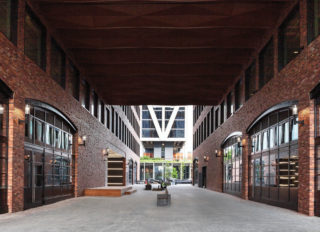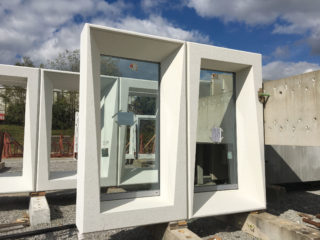The future of building materials requires advocacy for a one-stop, open-to-the-public, environmentally conscious building materials database. We as architects must make healthier, more sustainable material selections and specifications commonplace in the architecture, engineering, and construction industry, with continuity from the design process through the end of construction.
We often have an adverse reaction to building materials when opening a package of product samples or walking onto an active construction site—we are assaulted with potentially harmful odors. But we do not have this same reaction to a finished building. The materials have not been significantly altered, but our perception of them changes when experienced as part of a larger assembly or completed project.
Efforts to reduce environmental impacts within the architectural profession must address the needs of those who rely on designers and owners to speak for them. A large, broad, and often vulnerable population are the users of civic projects, including affordable housing, schools, libraries, healthcare facilities, and transit stations. In selecting materials, architects should factor in not only the potential impacts on the end user—for example, reducing or eliminating interior finish products that release harmful gases after installation—but also the impacts on the manufacturer and installer. As with much of the architectural industry, civic spaces and their end users are subject to market-driven impulses that usually consider cost and ease of material procurement. The future occupants, however, are largely left out of the discussion. Buildings can never be truly “environmentally conscious” if we don’t account for the effects of the components that go into their design.
Integrating sustainable, forward-looking materials (such as masonry with ground-glass pozzolan, carbon-neutral concrete, or even mushroom-based textiles) into projects, whether of a civic nature or not, requires thorough research and vetting, but also sharing information. Thoughtful material specifications can easily be undone during construction, whether through value engineering, changes in market availability, or a contractor’s unfamiliarity with a new or different product. Civic projects are often restricted by tight operational and construction budgets and require durable, long-lasting materials. Therefore, the benefits of such materials cannot be pushed without substantial proof of concept, and any cost considerations must be dealt with sensitively and openly.
Standards such as LEED, Green Globes, and Passive House offer pathways toward achieving and validating sustainably- minded design decisions, but guidelines for selecting materials can be murky and contradictory across platforms. Additionally, in the civic realm, some institutional clients and developers have deeply researched and tested material standards that do not always align with an architectural sustainable agenda. Often, selections are made based on durability and long-term maintenance, but may not factor in potential issues such as off-gassing over time or disposal at end of life.
Several beneficial existing platforms already exist, such as Health Product Declaration Collaborative and Parsons Healthy Material Lab, but can be limited by competing interests or specific agendas. The industry needs a publicly accessible unifying body and voice that consolidates this information.
The value of healthier or more sustainable materials is often intangible, and such selections can be overridden by the need to build and operate a building at an affordable cost. Part of the architect’s duty is to educate the client about the benefits of forward-looking materials so they become part of standard
practice; material selections must be architect-driven and client-supported. The research effort required to make this happen is not always an affordable reality for architects, who must either build it into project fees or have a separate stand-alone research and development department.
Bringing our research out into the open by advocating for a third-party platform to aggregate and filter through this work could help clarify and standardize material selections, benefitting us all in the future. If we are truly going to tackle architecture’s impact on the environment and address it as the crisis it is, we need to benefit from the research and work of our peers.
Greg Bencivengo, RA, is an architect at Dattner Architects. He views design as a combination of the rational and intuitive, and is intrigued by the potential of architecture to reflect and influence cultural and societal behavior.
Shefali Sanghvi, AIA, LEED AP BD + C, is a project manager and Studio Resource Leader at Dattner Architects and has over 14 years of affordable housing experience. She is dedicated to building energy- efficient buildings that are both socially and financially sustainable.













